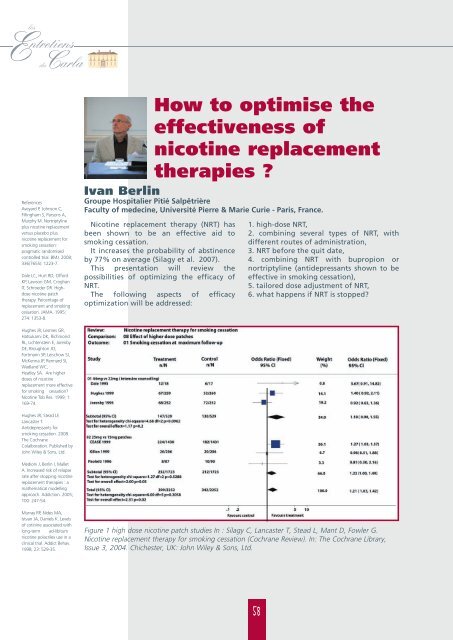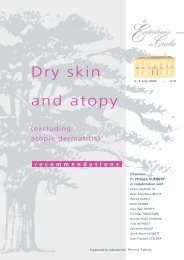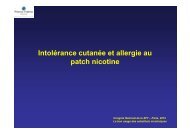Nicotine replacement therapy … - Carlos A ... - Entretiens du Carla
Nicotine replacement therapy … - Carlos A ... - Entretiens du Carla
Nicotine replacement therapy … - Carlos A ... - Entretiens du Carla
Create successful ePaper yourself
Turn your PDF publications into a flip-book with our unique Google optimized e-Paper software.
References<br />
Aveyard P, Johnson C,<br />
Fillingham S, Parsons A,<br />
Murphy M. Nortriptyline<br />
plus nicotine <strong>replacement</strong><br />
versus placebo plus<br />
nicotine <strong>replacement</strong> for<br />
smoking cessation:<br />
pragmatic randomised<br />
controlled trial. BMJ. 2008;<br />
336(7655): 1223-7.<br />
Dale LC, Hurt RD, Offord<br />
KP, Lawson GM, Croghan<br />
IT, Schroeder DR. Highdose<br />
nicotine patch<br />
<strong>therapy</strong>. Percentage of<br />
<strong>replacement</strong> and smoking<br />
cessation. JAMA. 1995;<br />
274: 1353-8.<br />
Hughes JR, Lesmes GR,<br />
Hatsukami DK, Richmond<br />
RL, Lichtenstein E, Jorenby<br />
DE, Broughton JO,<br />
Fortmann SP, Leischow SJ,<br />
McKenna JP, Rennard SI,<br />
Wadland WC,<br />
Heatley SA. Are higher<br />
doses of nicotine<br />
<strong>replacement</strong> more effective<br />
for smoking cessation?<br />
<strong>Nicotine</strong> Tob Res. 1999; 1:<br />
169-74.<br />
Hughes JR, Stead LF,<br />
Lancaster T.<br />
Antidepressants for<br />
smoking cessation. 2008.<br />
The Cochrane<br />
Colalboration. Published by<br />
John Wiley & Sons, Ltd.<br />
Medioni J, Berlin I, Mallet<br />
A. Increased risk of relapse<br />
rate after stopping nicotine<br />
<strong>replacement</strong> therapies : a<br />
mathematical modelling<br />
approach. Addiction. 2005;<br />
100: 247-54.<br />
Murray RP, Nides MA,<br />
Istvan JA, Daniels K. Levels<br />
of cotinine associated with<br />
long-term ad-libitum<br />
nicotine polacrilex use in a<br />
clinical trial. Addict Behav.<br />
1998; 23: 529-35.<br />
How to optimise the<br />
effectiveness of<br />
nicotine <strong>replacement</strong><br />
therapies ?<br />
Ivan Berlin<br />
Groupe Hospitalier Pitié Salpêtrière<br />
Faculty of medecine, Université Pierre & Marie Curie - Paris, France.<br />
<strong>Nicotine</strong> <strong>replacement</strong> <strong>therapy</strong> (NRT) has<br />
been shown to be an effective aid to<br />
smoking cessation.<br />
It increases the probability of abstinence<br />
by 77% on average (Silagy et al. 2007).<br />
This presentation will review the<br />
possibilities of optimizing the efficacy of<br />
NRT.<br />
The following aspects of efficacy<br />
optimization will be addressed:<br />
1. high-dose NRT,<br />
2. combining several types of NRT, with<br />
different routes of administration,<br />
3. NRT before the quit date,<br />
4. combining NRT with bupropion or<br />
nortriptyline (antidepressants shown to be<br />
effective in smoking cessation),<br />
5. tailored dose adjustment of NRT,<br />
6. what happens if NRT is stopped?<br />
Figure 1 high dose nicotine patch studies In : Silagy C, Lancaster T, Stead L, Mant D, Fowler G.<br />
<strong>Nicotine</strong> <strong>replacement</strong> <strong>therapy</strong> for smoking cessation (Cochrane Review). In: The Cochrane Library,<br />
Issue 3, 2004. Chichester, UK: John Wiley & Sons, Ltd.<br />
58






